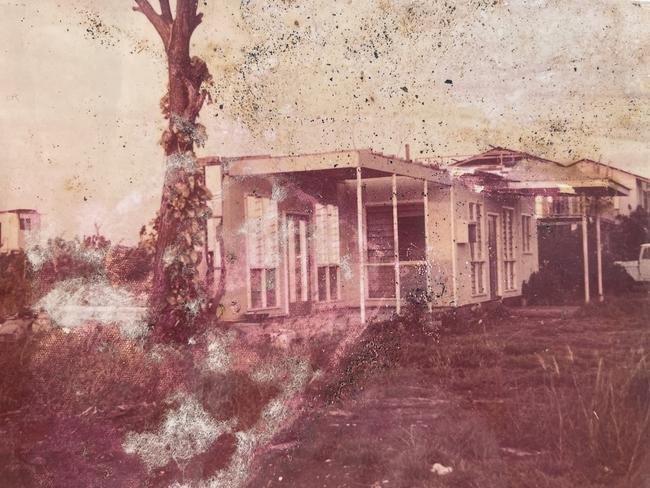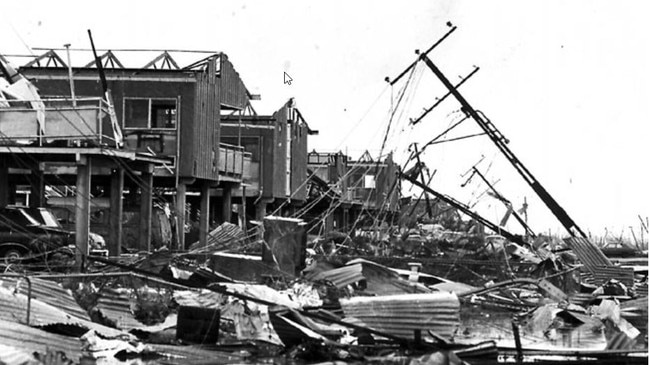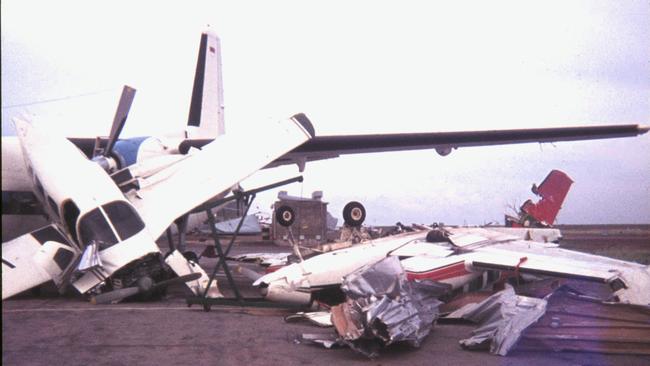‘Four people I know died’: Cyclone Tracy survivor Peter Haigh
A survivor of Cyclone Tracy and long-time Townsville resident is asking locals to stop underestimating the risk this season and take every oncoming cyclone seriously.

Townsville
Don't miss out on the headlines from Townsville. Followed categories will be added to My News.
Fifty years ago Peter Haigh was a young Victorian man in Darwin, and he’d never been through a cyclone before.
It was Christmas Eve, and he’d just knocked off work at the railway workshop and was heading over to the pub with some workmates.
“Most of us had never been through a cyclone, and they said on the radio a cyclone was coming but no one took it seriously,” Mr Haigh remembered.
“There had been a cyclone two weeks before but it veered off and went down the coast. Such a big deal was made about preparing for it, but nothing happened, so when they warned about this one everyone ignored it.”
As the workmates shuffled into the Railway Club, Mr Haigh has a clear memory of the sky before the sun went down.

“I was looking northwest, and it was like a fog was coming in through the sky. I had never seen anything like it. There was very little wind, after that started a very fine drizzling rain.”
After the pub, the group went home to a mate’s Queenslander-style railway commission house that looked over the Stuart Hwy.
“By that time the wind and rain was getting worse. There were six of us and a dog in the house,” Mr Haigh said.
“I couldn’t say for sure but it was maybe 10pm when it got bad. We were all in the lounge room and the roof started to rip off.”
The group moved to the bathroom, but water was pouring over them from the destroyed roof.
“We ended up in the back hallway holding mattresses over the top of us. By midnight the wind was screaming, you’ve never heard anything like it.”
The roof was off, the house was falling apart, houses all along the street were falling apart, and sheets of iron, wood, and anything the wind could find was rocketing through the air.
The strangest thing was how silent the destruction was.
It was impossible to hear the tearing of iron over the wind.

To this day the memories are still vivid for Mr Haigh.
“I’m not telling this story because I want to be seen as a hero, I’m telling it because people need to stop underestimating cyclones,” he said.
“If there is one thing I’ve learnt, it is listen to the radio, listen to the media when they’re telling you to prepare. You need to be very, very cautious of any cyclone.”

Mr Haigh said when the eye of Cyclone Tracy passed over, one of his mates got up to get beer from the fridge.
“We wanted to get up too, but he’d been through Cyclone Althea in Townsville. He told us to stay under the mattresses because he didn’t know when the wind was going to come back,” Mr Haigh said.
“There was a light breeze in the eye. It lasted about half an hour and then the wind came back, this time from the other direction, and it was like ‘well, shit’ because it was worse.”
The men sheltered under their drenched mattresses until 3.30am when the wind started to drop.

By 5am, the cyclone was easing and Mr Haigh went to the backdoor.
“There was nothing left of all the houses along the street,” he said.
“There might’ve been a wall still standing here and there. All the people who lived in them had stayed safe by going down into their concert laundry rooms under the houses when the eye passed over.”

The wind reader at the airport broke during Cyclone Tracy at 217km/h – Mr Haigh believes the wind likely got up to 250km/h.
He said everyone was in shock, and they wandered the streets visiting houses to see if those inside were all right.
“The most amazing part was there were hardly any trees left, and if a tree was still standing, it didn’t have a single leaf,” he said.
“By 10am the sun came out, and it was stinking hot. Nobody had any power and there was no water, because there was no electricity to pump the water. I think it took two days before anyone else in Australia knew a cyclone had hit us.”
It was actually the local ABC reporters and Telecom workers who got the word out, reaching a Mount Isa operator using a small microwave link set up to relay the Queen’s Christmas message which hadn’t been destroyed in the cyclone.

For Christmas Day and Boxing Day, the people of Darwin congregated in the few houses still standing.
The most crucial thing the survivors did was clear the airport’s runway, allowing RAAF planes to land with emergency food supplies.
Mr Haigh and his railway mates gathered at the Railway Club and began searching for supplies, fetching a refrigerator wagon from the rail yards and a generator.
By week three the Railway Club was feeding close to 300 people three meals a day thanks to several old men who used to be station cooks.
Mr Haigh’s own single-bedroom workman’s flat had survived the cyclone without any damage, and several families began living out of it as they waited for evacuation.

Three days after Cyclone Tracy, Mr Haigh and a mate were searching through a truck driver’s rest room when they tried the shower’s taps.
“Water came out, and we immediately threw off our clothes and had our first shower in three days,” he said.
“It turned out those taps were connected to a tank up on a hill, and it was gravity fed. We also found the keys to a Mack truck and a delivery truck there so we took those.”
Mr Haigh became a truck driver, picking up supplies from the airport and running rations to the many emergency shelters in Darwin, including Ludmilla School which was housing masses of people.
“People were living under sheets of roofing iron and it stank of rotten food,” he said.
Mr Haigh said eventually he learnt to tell the difference between the smell of Christmas food rotting, and bodies rotting.

Fifty years later, he believes the death toll of Cyclone Tracy is much higher than the 66 reported.
“All I will say is I know four people who died, and only two are on the death list,” he said.
“I don’t know how three of them died. But one was a friend who lived in Fannie Bay with his six children. When his house was disintegrating he tried to lower his kids off the veranda onto the cars below and a piece of wood went through his chest.”
On December 28, a Qantas jumbo jet with all its seats ripped out landed in Darwin and boarded a record breaking 673 evacuees.

“They took off with all the elderly, women and children. Nearly everyone left Darwin, and only 10,000 stayed,” Mr Haigh said.
At the time approximately 47,000 people lived in Darwin - about 35,000 evacuated after Cyclone Tracy.
Mr Haigh was one of the men who stayed behind to help clean up the town.
“After Cyclone Tracy a lot of people left and not many came back. There was a lot of chippies and tradies who flew up on the evacuation planes and there was an influx of new people, and there was a feeling that they weren’t like us,” he said.
“The best days of my life were in Darwin before the cyclone. It was a very good community. After Tracy it was different.”
According to Geoscience Australia, Cyclone Tracy holds the record as the smallest observed tropical cyclone in the world, with a gale radius of less than 50kms.
Despite her tiny size, she left a huge mark on Australian society and was the key force behind the introduction of Australia’s cyclone building codes.
Originally published as ‘Four people I know died’: Cyclone Tracy survivor Peter Haigh





